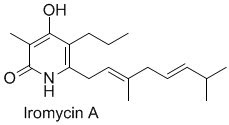
Onyango, Tsurumoto, Imai, Takahashi, Ishihara, Hatakeyama. ACIEE, 2007, Early View, DOI: 10.1002/anie.200702229
Neooxazolomycin was isolated by Uemura in 1985, together with the oxazolomycin, this oxazole polyene lactam-lactone antibiotics was synthesized first by Kende in 1990.
But I find interesting the way to achieve the synthesis of the furo-pyrrole moiety (lactam-lactone) by Hatakeyama. This synthesis, I present you, starts from the reaction of heptynol (see below) and tetramethyldisilazane ((HMe2Si)2NH) provides hydromethylsilylether (not shown) which upon treatment with Pt(dvds) as catalyst in THF gives the cyclic siloxane. After iodination with I2 in presence of CsF in a DMF/MeOH mixture, the iodoalkenol is obtained in 82% (3 steps). The synthesis continues with the oxidation of the alcohol under Jones conditions, and the carboxylic acid is condensed with 2-(methylamino)malonate through the acid chloride to provide the amide in 62% Yield (3 steps). The cyclization of the alkenyl amide with the Pd(OAc)2/PPh3 couple, K2CO3 and nBu4NBr in solution in DMF results in the formation of the alkylidene-pyrrolidinone in 84% yield. The crucial step is undoubtedly the stereoselective dihydroxylation using OsO4/NMO with a concomitant lactonization to furnish lactam-lactone moiety in 88% yield.

A very interersting paper with a lot of different chemistry: Reformatsky, Stille, Nozaki-Hiyama-Kishi, Tamao hydrosilylation, Dihydroxylation.









